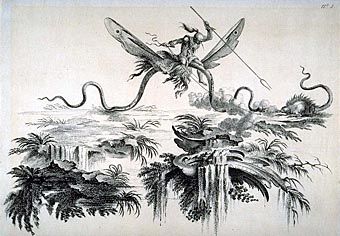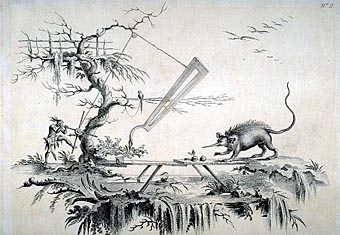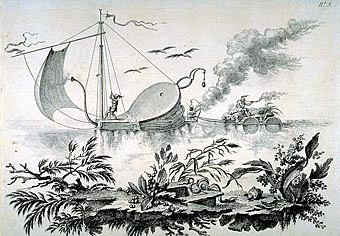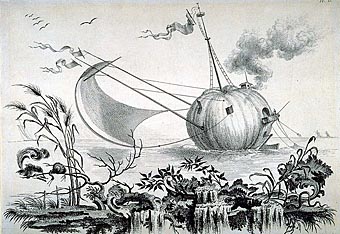
It’s a shame there isn’t more of this imaginative work from Filippo Morghen (1730–1777). In a series of etchings from around 1766 he presents the moon as a tropical world inhabited by the 18th century conception of New World savages. I especially like the hunter on his winged serpent (above) and the elaborate trap set to behead a wary beast (below). The explanatory text is from this print collection which also has large copies of the pictures.
Filippo Morghen was a member of a large family of artists. His brother Giovanni was a painter and printmaker and his son, Rafaello, was a printmaker who specialized in reproductive prints after Raphael and Leonardo. Filippo himself was a designer and printmaker. In addition to the present series on the theme of a voyage to the moon, Morghen is known for a series of plates detailing antiquities from Herculaneum and for views of the environs of Naples.
This set of fanciful etchings is dedicated to William Hamilton, an envoy to the court of Naples. Morghen’s exuberant rococo style, with ornamental passages of chinoiserie, makes for a curious and playful description of a voyage to the moon. There were many seventeenth-century treatises dealing with the possibility of a voyage to the moon. Morghen, perhaps through Hamilton, apparently knew that Philippe de la Hire (whose name appears in the title) did not believe the moon was inhabited. A later edition of the series substitued the figure of Bishop John Wilkins for that of Wild Scull (de la Hire’s travelling companion). Wilkins had published The Discovery of a World in the Moone in 1638.



Elsewhere on { feuilleton }
• The etching and engraving archive
